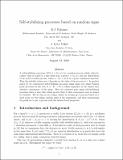Files in this item
Self-stabilizing processes based on random signs
Item metadata
| dc.contributor.author | Falconer, K. J. | |
| dc.contributor.author | Lévy Véhel, J. | |
| dc.date.accessioned | 2019-09-28T23:37:25Z | |
| dc.date.available | 2019-09-28T23:37:25Z | |
| dc.date.issued | 2020-03 | |
| dc.identifier | 252316577 | |
| dc.identifier | fbb707b1-b7fb-45f2-b229-e9cc44a3505b | |
| dc.identifier | 85048531167 | |
| dc.identifier | 000530548400006 | |
| dc.identifier.citation | Falconer , K J & Lévy Véhel , J 2020 , ' Self-stabilizing processes based on random signs ' , Journal of Theoretical Probability , vol. 33 , no. 1 , pp. 134-152 . https://doi.org/10.1007/s10959-018-0862-9 | en |
| dc.identifier.issn | 0894-9840 | |
| dc.identifier.other | ORCID: /0000-0001-8823-0406/work/58055271 | |
| dc.identifier.uri | https://hdl.handle.net/10023/18576 | |
| dc.description.abstract | A self-stabilizing processes {Z(t), t ∈ [t0,t1)} is a random process which when localized, that is scaled to a fine limit near a given t ∈ [t0,t1), has the distribution of an α(Z(t))-stable process, where α:ℝ→(0,2) is a given continuous function. Thus the stability index near t depends on the value of the process at t. In an earlier paper we constructed self-stabilizing processes using sums over plane Poisson point processes in the case of α:ℝ→(0,1) which depended on the almost sure absolute convergence of the sums. Here we construct pure jump self-stabilizing processes when α may take values greater than 1 when convergence may no longer be absolute. We do this in two stages, firstly by setting up a process based on a fixed point set but taking random signs of the summands, and then randomizing the point set to get a process with the desired local properties. | |
| dc.format.extent | 19 | |
| dc.format.extent | 297913 | |
| dc.language.iso | eng | |
| dc.relation.ispartof | Journal of Theoretical Probability | en |
| dc.subject | Self-similar process | en |
| dc.subject | Stable process | en |
| dc.subject | Localisable process | en |
| dc.subject | Multistable process | en |
| dc.subject | Poisson point process | en |
| dc.subject | QA Mathematics | en |
| dc.subject | T-NDAS | en |
| dc.subject.lcc | QA | en |
| dc.title | Self-stabilizing processes based on random signs | en |
| dc.type | Journal article | en |
| dc.contributor.institution | University of St Andrews. Pure Mathematics | en |
| dc.identifier.doi | https://doi.org/10.1007/s10959-018-0862-9 | |
| dc.description.status | Peer reviewed | en |
| dc.date.embargoedUntil | 2019-09-29 | |
| dc.identifier.url | https://rdcu.be/77og | en |
| dc.identifier.url | https://arxiv.org/abs/1802.03231 | en |
This item appears in the following Collection(s)
Items in the St Andrews Research Repository are protected by copyright, with all rights reserved, unless otherwise indicated.

